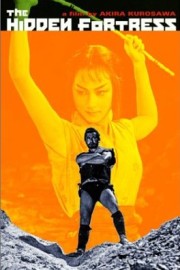The Hidden Fortress
If someone wanted to get into foreign films, but wasn’t sure of where to start, the first filmmaker I would have them watch is Akira Kurosawa. Aside from the fact that he is among the greatest of all directors, his films have had such profound impact on American cinema, and especially, the action-adventure genre, that films like “Seven Samurai,” “Rashomon” and the twin samurai westerns “Yojimbo” and “Sanjuro” would be easily digestible to modern viewers, in much the same way that “Crouching Tiger Hidden Dragon” was fifteen years ago. Kurosawa’s 1958 samurai adventure, “The Hidden Fortress,” would be easily added to that list, as well, but of course, I already knew that going in to watching the film again this week.
Even if you’ve never seen “The Hidden Fortress,” it’s likely you’ve felt it’s influence, and heard the name. This was the Kurosawa film that George Lucas was inspired most by while writing the script for “Star Wars: Episode IV- A New Hope.” Yes, the serialized nature of “Flash Gordon” provided the most obvious structural choices and space opera motifs for Lucas’s sci-fi fantasy, but the straightline narrative takes more of it’s cues from the screenplay by Kurosawa, Ryûzô Kikushima, Hideo Oguni and Shinobu Hashimoto as they tell the story of a land torn apart by war. Set in feudal Japan, we begin our journey following the characters of Tahei (Minoru Chiaki) and Matakisihi (Kamatari Fujiwara), two friends who went off to war to find fortune, but ended up mistaken for the enemy and digging mass graves instead. As they return home, we see them bickering, and anyone familiar with “A New Hope” will not miss the parallels these characters have with the dynamic between C-3PO and R2-D2, and George Lucas has even admitted as much himself. What matters most, however, is that once they are reunited after going their separate ways, they find bars of gold that one of the armies has been searching for. They soon find themselves being followed by an imposing samurai named Rokurota Makabe (Toshirô Mifune), a once-great general in their land’s army before they were overrun. Now, he is trying to get to a safe land with the Princess Yuki (Misa Uehara) with the gold found by Tahei and Matakisihi, and the friends will help them, although they think the princess is simply a dumb, mute companion. Writing out much of those last few sentences, I could almost be outlining the story of the “Star Wars” saga, in general, as “The Phantom Menace” certainly borrows elements of Kurosawa’s film, as well.
It’s easy to see, in watching them, the greatness of something like “Seven Samurai,” “Kagemusha” and “Ran,” but “The Hidden Fortress” is a different thing, altogether. This is the most overtly “fun” movie of the great filmmaker’s samurai films; this feels much more like an escapist adventure than the gritty, violent action dramas at the center of those other films. That sense of fun starts immediately with the first scene between Tahei and Matakisihi, and doesn’t let up in the next 138 minutes. I will admit that their schtick gets a bit old at times (especially when we see their true nature against the need for some conflict in the script), but they are an engaging pair of travelers that liven up the proceedings compared to the straight-faced General Makabe and Princess Yuki. Makabe may be a bit of a buzzkill for Tahei and Matakisihi with his serious demeanor, but as played by the great Mifune (whom Lucas apparently asked to play Obi-Wan for “A New Hope”), he may be intimidating, but he’s also a wry action hero, a template that would serve Harrison Ford well as Han Solo and Indiana Jones, but also was important when the actor played Sanjuro in Kurosawa’s duel samurai dramas, “Yojimbo” and “Sanjuro,” a few years later. It’s easy to see why films from the “Star Wars” series to Spielberg’s “War of the Worlds” to Miyazaki’s “Princess Mononoke” owe it a debt in terms of how they tell their stories.
While the men offer a lot of fun moments throughout the film’s two-plus hours (and in Mifune’s case, the action, as only K could deliver), it’s the woman at the center of the story that provides it’s heart. Yuki is the most important character in the movie, and Uehara can more than hold her own against the legendary Mifune with her striking face and eyebrows. A hunted woman, set for execution after her army is overrun, Yuki is “disguised” as a peasant who is traveling with Makabe to a save territory. Along the way, she sees the lives of regular people like Tahei and Matakisihi more clearly than she’s been able to before, and it humbles her. It’s a smart turn and wise plot development in another otherwise standard adventure formula movie, and it’s the type of thing Kurosawa used to transform action into art, and give a typical journey an unusual sense of purpose and emotion. This is best seen when the group find themselves in the middle of a fire festival with their gold (which is hidden in branches of wood). It’s the most fun moment in the story for Yuki, and brings her closer to her people in a way ruling them never could. Those type of moments exemplified the finest in Kurosawa’s cinema, and makes “The Hidden Fortress” feel less like a second tier effort for the great director, and lands it’s clearly in the top rung of his body of work.










